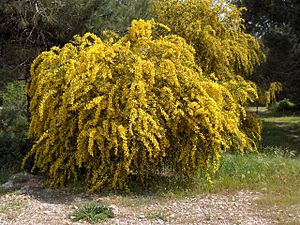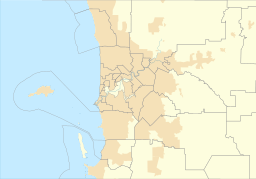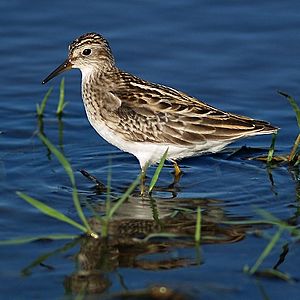Forrestdale Lake facts for kids
Quick facts for kids Forrestdale Lake |
|
|---|---|
 |
|
| Location | Perth, Western Australia |
| Coordinates | 32°09′30″S 115°56′16″E / 32.15833°S 115.93778°E |
| Type | Brackish seasonal groundwater |
| Primary outflows | groundwater; evaporation |
| Basin countries | Australia |
| Designation | Forrestdale Lake Nature Reserve; Forrestdale and Thomsons Lakes Ramsar Site |
| Max. length | 1.6 km (0.99 mi) |
| Max. width | 1.3 km (0.81 mi) |
| Surface area | 2.45 km2 (0.95 sq mi) |
| Surface elevation | 22 m (72 ft) |
Forrestdale Lake Nature Reserve is a special lake and nature reserve in Western Australia. It's located about 25 kilometers (15 miles) south of Perth, the state capital. The reserve is found on the southern edge of the Perth city area.
This natural wetland is still mostly untouched, with native plants growing nearby. Even though it's surrounded by homes and farms, it's a very important place. Many shorebirds and other waterbirds visit or live here regularly.
Contents
History of Forrestdale Lake
Ancient Times and Aboriginal Connections
Long before European settlers arrived, Aboriginal people used Forrestdale Lake. It was an important place for hunting tortoises. They would set up camps here and stay for long periods.
The lake is connected to the story of the Wagyl, a powerful water serpent in Noongar mythology. The Wagyl is believed to have created rivers and lakes and keeps the water flowing to its resting spots.
Early European Settlers
The first non-Aboriginal settlers came in 1885. William and Alfred Skeet were given permission to use land next to the lake. They also had licenses to cut and sell timber.
Farming began around the lake in 1893. People cleared much of the land to try growing crops. They also started dairy and poultry farming. By 1898, the area was planned to become a town. The Jandakot region, where the lake is, started producing vegetables, honey, and dairy products for nearby markets.
From the 1920s, farming changed to raising sheep and cattle. This continued for the next 50 years. In the 1940s, livestock heavily grazed the west side of the lake. This was especially true in dry summers when the plants around the lake were extra food. Because of this, the land on the west side now has fewer native plants and many introduced plants like arum lilies.
Protecting the Lake
In 1957, the lake was officially made an A-class Nature Reserve. This was to protect its plants and animals, and also for fun activities like sailing. The number of people living in the Forrestdale area grew quickly in the late 1960s. Today, about 1350 people live there.
The lake was first called Lake Jandakot but was renamed Forrestdale in 1973. It was recognized as an important national site in 1978. Forrestdale Lake and Thomsons Lake, which is 10 kilometers (6 miles) west, together form the Forrestdale and Thomsons Lakes Ramsar Site. This means they are wetlands of international importance, recognized in 1990.
In 1998, the reserve's main goal became simply "Conservation of Flora and Fauna" (protecting plants and animals). It is now managed by the Department of Biodiversity, Conservation and Attractions. People mainly use the reserve for birdwatching, nature walks, horse riding, and general outdoor fun.
What Forrestdale Lake is Like
Forrestdale Lake is a shallow, slightly salty lake that changes with the seasons. When it's full, it has a large open water area of about 220 to 245 hectares (540 to 600 acres). It has many sedges, which are grass-like plants, around its edges. These are typical of the Swan Coastal Plain.
The lake is a major place for waterbirds to breed, stop during migration, and find safety during droughts. It usually dries out by mid-summer. Houses are very close to the lake on the north-east side, sometimes only 50 meters (160 feet) away. On the west, land has been developed for farming or homes, about 100 meters (330 feet) from the shore. There is a large area of natural open woodland on the eastern side.
How the Lake Works: Water and Land
The lake sits on the eastern edge of the Bassendean Dune System. This area is mostly made of light grey-white sand. The lake itself is a basin formed by wind, surrounded by low sand ridges up to five meters (16 feet) high. There's a rocky sandstone outcrop on the north-eastern edge. The lake bed has layers of clay, silt, peat, and limestone up to two meters (6.5 feet) thick.
Forrestdale Lake is also on the edge of the Jandakot Mound. This is an area where the underground water level is higher. Water levels in the lake were much higher in the 1970s and 80s. However, they have been going down steadily since 1992. Underground water levels have also dropped since 1996. The lake now dries out earlier than it used to in wetter years.
Amazing Plants and Animals

The water in Forrestdale Lake often has a thick mat of plants like fennel pondweed, stoneworts, and ditch grasses. Around the open water, there's a nearly continuous belt of the introduced bulrush Typha orientalis. Behind these, you'll find various sedges, rushes, and reeds.
Further back, there's a belt of trees, mostly paperbarks and swamp banksia. Behind them are orange wattle and flooded gum. The higher sandy ground on the eastern side has open woodland with many candlestick banksia trees.
About 351 different types of vascular plants have been found in the nature reserve. Of these, 99 are introduced weeds. Twenty-six types of algae have also been recorded.
More than 20,000 waterbirds have been seen at Forrestdale Lake. It often supports more than 1% of Australia's total population of five different shorebirds:
- Red-capped plover (up to 1,300 seen at once)
- Black-winged stilt (3,840)
- Red-necked avocet (1,113)
- Long-toed stint (up to 80)
- Curlew sandpiper (2,000)
In some years, the lake is home to over 10,000 ducks, including:
- Australian shelduck (up to 1,650 counted)
- Pacific black duck (5,500)
- Grey teal (9,000)
- Australasian shoveler (2,000)
- Hardhead (1,053)
Forrestdale Lake is one of the few places in Western Australia where little ringed plover and little stint have been seen more than once. It's also the only place in the state where the white-rumped sandpiper has been recorded.
Besides the rare skink Lerista lineata, Forrestdale Lake is home to six types of frogs. It also has at least 62 different kinds of aquatic invertebrates (animals without backbones). The long-necked tortoise lives here too.
The critically endangered Australian native bee, Neopasiphae simplicior, is thought to live only in the bushland of the Forrestdale Lake Nature Reserve.
Keeping the Lake Safe: Challenges
There are some challenges to keeping Forrestdale Lake healthy.
- Using pesticides to control midges (tiny insects) can harm other aquatic animals and birds. In 1984, about 220 shorebirds died at the lake because of such spraying.
- Taking too much underground water might make the already dropping water levels even worse.
- The amount of bulrushes around the lake has increased. This can change the types of plants growing there, reduce the open water, and shrink the muddy areas that migratory shorebirds need.
- People and dogs can disturb waterbirds, especially in late summer and autumn when the lake is drying out.
- More buildings and development in the surrounding area could change the water balance or increase the already high nutrient levels in the lake.




